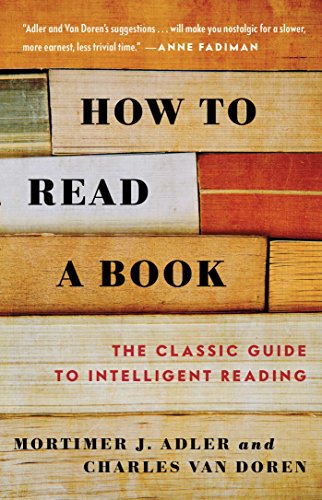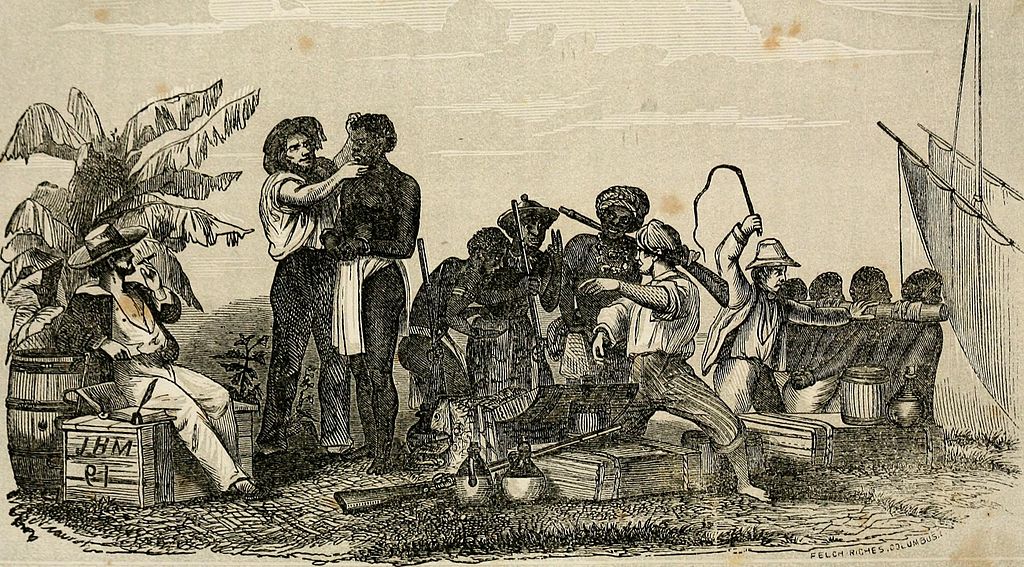The Most Important Book You’ll Read This Year (Besides The Bible)
Recently, I finished a book that has been sitting unread on my shelf for a few years. I admit that one of the main reasons I bought it was for one of its appendices – where it gives a list of the great books that one ought to read. I’d open it every once in a while, read through the list in the back for ideas on what to read next, and then put it back on the shelf. I had started it, stopped it, flipped through it, but never completed it. Now, that I have, it’s a book that I wish I would have known about in high school because it would have impacted me for the rest of my life.
What book is this, you ask? It’s titled very simply How To Read A Book: The Classic Guide To Intelligent Reading, by Mortimer J. Adler and Charles Van Doren. The book was originally written in 1940 to fill what Adler saw as the need to continue peoples’ reading skills beyond the instruction they received in grade school. He and Van Doren later updated it in 1972 in order to flesh out some of the sections a little further. Also, in the 1970s, the Secretary of Education in the U.S. had declared it the Decade of Reading. This meant federal funds were being poured into reading education in the schools.
As for adults, speed reading courses became wildly popular. Yet, still, the kind of training that people were receiving didn’t go much further than what Adler calls the Elementary level. So a rewrite of his book was in order to meet the increased amount of reading being done here in the U.S.
The Four Levels of Reading
Adler’s main concept for getting us to become better readers is by describing four increasingly higher levels of reading. He calls these levels Elementary, Inspectional, Analytical, and Synoptic – each requiring more and more engagement with a work or topic. Also, each increasing level of reading includes the level before it. So, for example, in order to do Analytical reading, one must first have done Inspectional reading. And, before one can do Inspectional reading, one must be able to do Elementary reading.
Elementary Reading
Elementary reading is the foundation of all other reading levels. This is the type of reading we learn in grade school. We learn what the black marks on the paper are, how they come together to form words, how words form sentences, sentences for paragraphs, etc. And, really, that’s about it all the way through high school. The main differences between the various grade levels have mostly to do with our increase in vocabulary and complexity of sentence structure. Sure, we are asked to think a little deeper about the ideas expressed in a book, but that’s about it.
It’s not much different when we head off to college. We are handed books to read, told to break them down, and asked to answer a few questions about them. But, the “how-to” instruction doesn’t increase.
Inspectional Reading
Adler proposes there are 3 more levels of reading after the elementary level. The next level is what he calls inspectional reading. At this stage, the point is to get the general idea of the book before you start reading it. This is done by reading the dust jacket, spending time in the table of contents, and skimming through the chapters and section titles. This process serves a couple of purposes. First, by spending time in the table of contents and flipping through the chapters, you’ll get an idea if this is a book you even want to read in the first place. Second, by familiarizing yourself with the author’s train of thought, you’ll know when certain questions get asked and when questions you come up with will get answered.
This process doesn’t work quite the same with works of fiction. Obviously, you don’t want to know what happens in the end before you start reading the book. But, you can still take some time with the book before you get started to know if it’s worth your time or not.
Analytical Reading
The third level of reading – and the level that gets the most attention in the book – is analytical reading. At this level, you start by identifying the type of book you are reading. Is it fiction? A historical text? Mathematics or Science? Philosophy? Opinion? If you are like I was, you may think of this and say “duh. OK, that was easy. What’s the big deal?” The big deal comes later when Adler devotes a chapter to each of the main types and tells you how to read them. There are different rules for reading fiction than there are mathematics books. You ask different questions about a historical book than you do a philosophy book. Getting the type right in the beginning puts you in the right mindset for engaging with the book as you read it.
Other chapters in this section deal with the importance of outlining the book, letting the author define the terms he or she is using, locating the key themes and arguments the author poses, understanding the solutions he or she offers, giving a fair critique of the book, and how to agree or disagree with the author.
After giving us thorough instruction on analytical reading, Adler gives us several chapters on how to read specific types of books. In school, we are taught there are two basic types of books – fiction and non-fiction. Sure, we are taught about genres, but we aren’t really told what to do with that information. The chapters in this section are extremely helpful because they give you guidelines on how to deal with each of the different types of books. In these chapters, Adler gives you an idea of how to read practical books, imaginative works, poems, plays, history, science and mathematics, philosophy, and social science books. The way you engage with a history book should be different than the way you engage with a science book or a practical guide (a “how-to” book so to speak). This just makes sense.
Synoptic Reading
The final level of reading is what Adler calls Synoptic reading. This takes all of the other levels of reading and combines them on a large scale. When you read synoptically, you are usually doing so on a specific area of interest. In almost every case, you cannot consider yourself fully informed on a topic if you read only one book on that topic. This is especially true in the areas of Christian doctrine and theology. Most doctrines have differing perspectives. So, before you can consider yourself informed on an issue, you need to read all sides of it and then come to your conclusion.
Let’s say you want to learn more about the topic of guitars. You would start by compiling a list of all the books on guitars. You would then read them inspectionally in order to determine if they would be worth your time reading. Maybe only a few paragraphs of a book pertain to your area of focus. Maybe the whole book does. You would go through your entire list this way until you determine what books to focus on and what parts of the book have to do with your topic. And then, finally, you read each of the pertinent books analytically – asking it and the author questions based on the type of work that it is.
Synoptic reading is something that most of us probably won’t use. Unless that is, we are writing a book or doing in-depth research for something else like a thesis. Depending on the topic you are studying, it could take years to make it through the list of books you have compiled. Most of us won’t likely go through an exercise like this.
There are a lot of great lessons in this book that I wish I had known in my high school and college days. First, when reading a book, only read that book to understand what it is about. In other words, don’t read a bunch of commentaries, summaries, biographies, etc before you read the book. Let the book (and therefore the author) speak for itself. Try your best to only deal with the arguments as they are presented in the book and then determine if you agree or disagree with them.
If you read a bunch of stuff about the book before you read it, you are limiting yourself. The problem with doing this is the person writing the summary is, by nature, leaving a bunch of stuff out. Also, they are only putting in what they think is important. By reading these, you will come to the book with a bunch of preconceived ideas and start to form conclusions before reading the first page.
To be fair, it’s really hard to avoid doing this these days. One of the first things I usually do when I find a book I want to read is to go on Amazon and Goodreads to see the rating and read some reviews. I get it. We have limited time, so we want to try and judge which books are worth our time to read. But, we need to be careful not to completely discount a book that we first found interesting because someone wrote a bad review about it.
Along those same lines, we need to be careful not to spend more time in commentaries about the book than we do the book itself. The Christian book market is especially bad at this. There are tons and tons of books written about what the Bible says – books on applying Scripture to every modern topic and issue, books on living a better life, books on prayer, books on Biblical marriage, books on how to raise your kids, and on and on. Now, don’t get me wrong – a lot of these books are great and do a wonderful job of presenting what Scripture says. But, sometimes they can keep us from going to where the real gold is – the Bible itself.
How This Book Can Help Your Bible Study
As I was reading through the analytical chapters, it was interesting to see Adler discuss techniques that I had learned to apply to my Bible study. Firstly, the discussion on genres is important. When you start reading one of the books of the Bible, you need to first understand what genre you are dealing with. Some books fall into the history genre, some into the wisdom genre, some into the poetry genre, etc. Getting the type of book right is the first step to knowing what questions to ask of it.
Second, being able to outline a book is important. Seeing the author’s flow of thought and organization of ideas is key to getting the overall message. For example, the authors of the gospels document hundreds of interactions Jesus had with other people. These are rarely meant to be read in isolation. Oftentimes, Jesus has an encounter with the religious leaders to make a point followed by an encounter with a regular citizen demonstrating it. If you read one but not the other, you either miss the point of the encounter with the commoner, or you don’t see the point he made work out in real life.
Along those same lines, we cannot latch onto Bible verses in isolation. The authors never intended us to. I’ve written more on this idea here.
How This Book Can Make You A Better Christian Case Maker
In our current day and age, we are overloaded with information, data, and especially opinions. It’s really easy for us to feel “informed” on a topic because we have read a few pages on the internet. I’m certainly guilty of this myself. So, I think some of the most valuable chapters in the book for me are the ones dealing with criticizing a book fairly and agreeing or disagreeing with the author.
These chapters are important for two reasons. First, if I only read books from authors I know I’m going to agree with, then I will never grow. How can I fairly critique something I have never read or watched? And, if something I believe really is true, it should stand up against what is false. I shouldn’t be afraid to have my positions challenged. I should also be able to defend my position as true. Reading things that differ with me helps to do that.
Second, if we want people who disagree with the Bible to read it, then we need to show the same consideration to them to a certain degree. If I want an atheist to consider the Bible, then I need to be willing to read the works of atheist thinkers. Doing so not only shows a willingness to have your mind changed on things, it also allows you to discuss the concepts brought up by those authors. It’s one thing to discuss a book by an atheist because you read an article somewhere. It’s another thing to discuss the book because you’ve read it. After all, a good Christian Ambassador knows the foreign territory he or she is engaging with in order to share the gospel more effectively.
How This Book Can Change The Culture
It is true that fewer and fewer people are reading books. More of us are getting our information from the news, videos on the internet, and articles posted on Facebook. But, the book industry is still a big moneymaker and very much alive. And many of the principles given here could be applied to any medium. Most of what we engage with these days has a great deal of rhetorical flair and pleas to our emotions as ways to get us to think a certain way or do a certain thing or vote for a certain person. Applying the principles in this book would help us cut through all of that, engage with content in a mature manner, and have better discussion about important issues to actually come up with good solutions.
Share This Story, Choose Your Platform!
latest video
news via inbox
Nulla turp dis cursus. Integer liberos euismod pretium faucibua








